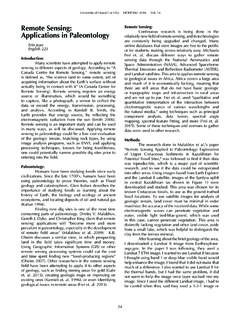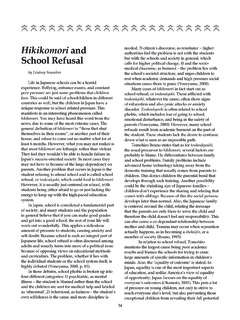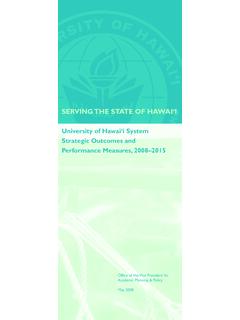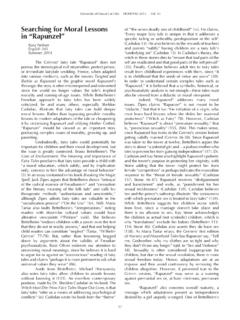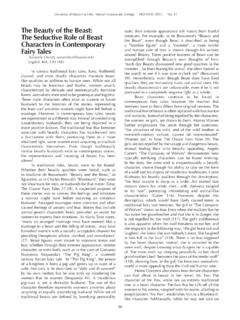Transcription of Sink or Float - University of Hawaii at Hilo
1 Partnerships for Reform through Investigative Science and Math Sink or Float 1 Concepts Marine debris can be hazardous to animals living in the ocean or on the land. Marine debris is carried to the sandy shore from many different sources including wind, waves, tides, currents, and humans. Materials that make up marine debris that are transported to the sandy shore can either Float or sink. HCPS III Benchmarks SC SC Duration 1 hour Source Material PRISM Vocabulary Entanglement Hazard Strangle Choking Drowning Recycle Sink or Float Summary Students will investigate and discover the types of objects that sink or Float in water. They will make predictions about which items will sink or Float and record their predictions on a datasheet. They will discover through hands-on experimentation whether their predictions were correct or not. They make connections between what they have discovered and the concept of marine debris in our oceans and on our beaches.
2 Objectives Students will classify materials that Float or sink in water. Students will learn about the characteristics of objects that either sink or Float . Students will understand how and why man-made objects become marine debris. Students will understand the ways the marine debris can be hazardous to marine life in the ocean and on the sandy shore. Students will understand how objects that sink or Float are transported to the sandy shore through natural processes. Materials 1 clear plastic tub per group 1 bag of 6 sink or Float objects per group ( wood, metal, aluminum, coins, plastic, paper, fishing line, netting, rubber, etc. ) 2 paper towels per group 1 sink or Float worksheet per student Making Connections Students may recall visits to the sandy shore when they have seen marine debris and trash on the beach. They may even have participated in organized beach clean-ups on the island. This lesson will help them understand what marine debris is, how it is generated, and how it made it to the sandy shore.
3 Teacher Prep for Activity Fill each plastic tub about full with water and place on each group s worktable. Copy one sink or Float worksheet for each student. Make the bag of objects to experiment with for each group plus a bag of extra objects in case objects are lost during the experiment. Sandy Shores Partnerships for Reform through Investigative Science and Math Sink or Float 2 Background Marine debris is trash that gets put into the marine environment from careless handling or disposal by humans. Trash can be buoyant making it easy to be blown around or can sink which makes it easy to be moved by physical processes in the ocean. Marine debris includes all objects found in the ocean that do not naturally occur there. The most common categories of marine debris include plastic, glass, rubber, metal, paper, wood, and cloth. Marine debris comes from many different sources. The main sources are humans, improper disposal of trash on land, storm water overflow, ships or other vessels dumping, and many others.
4 The main contributors are humans who visit the sandy shore habitat everyday and leave behind trash and other materials that can become marine debris. Examples of these items include food containers or wrappers, cans, cigarette butts, toys, and others. These items can then be blown into the ocean or washed in when it rains. Marine debris affects marine life and other wildlife in many ways. However, the two main hazards (harms) are entanglement and ingestion. Entanglement refers to instances where wildlife gets caught in or encircled by debris. This can lead to loss of limbs, choking or strangling, and loss of mobility that can lead to starvation and drowning. Marine mammals, turtles, birds, fish, and crustaceans have all been entangled in or eaten marine debris and suffered severe consequences and even death as a result. There are many ways that we can work together to reduce the amount of marine debris in our ocean and on our beaches. Recycling, not littering, and doing beach clean-ups are just a couple of ways we can help.
5 (For further reading on this topic see the resources listed below) Procedure 1. Read, define, and write the new vocabulary words on your list. Begin the lesson with a discussion about what types of things the students think sink or Float . Ask the students to think about things they have seen sink or Float and make a list for both categories on the board. Write the names of the items they recall under the correct category. (HINT: write down the type of material each item is made of. For example, if the students say plastic bags, then write plastic or if they say coins, then write metal, etc.) (~10 minutes) 2. Introduce the activity by explaining to the students that they will now have a chance to experiment with different objects to determine if they sink or Float . Also, write the headings found on the student datasheet on the board so students can follow along. 3. Separate the students in groups (HINT: groups of four or five is recommended) 4. Give each group a tub of water, one bag of sink or Float objects, and a sink or Float worksheet.
6 5. Have each group take the sink or Float items out of their bags and place each one on the table neatly in front of them. Have the students write the names of each item in the column on the left of the worksheet. Then, explain that in the second column they should make a prediction or guess about whether each object will sink or Float . Have students fold the datasheet so only the object name and prediction columns are showing. (This will prevent students from starting the experiment before a prediction has been made and prevents them from confusing these similar columns with one another).Give them a minute to think and then instruct them to circle the word sink or Float to show what their prediction is. Repeat this process for all six items until the entire guess column is complete. (steps 2, 3, 4, &5 should take ~10 minutes) Partnerships for Reform through Investigative Science and Math Sink or Float 3 6. Explain that they should now place each object into the water tub one at a time, following the order in which they wrote the names of their objects and circle the word sink or Float to show what happened to the object after they put it in the water.
7 (~10 minutes) 7. After they have finished experimenting with each item and recorded their answers, discuss the results as a group. Refer back to your original list on the board and discuss which items are in the correct categories and add the items they did not mention but learned about during the activity. 8. Some students may have found that the orientation and height from which the object was dropped into the water affected whether it sank or floated. Discuss this as a class. 9. Explain to the students that marine debris can be anything that does not belong in the ocean and is dumped, put, or dropped into the ocean by humans and gets washed up onto the sandy shore. There are 4 main ways that marine debris can be carried to the sandy shore including wind and waves or currents and tides. These may be new vocabulary words for the students so some explanation may be needed. A simple way to explain the terms for the purpose of this activity is: Wind & Waves are found at the surface of the ocean Currents & Tides are found below the surface of the ocean A diagram like seen below is helpful for the students to visualize the methods of movement in the ocean.
8 (Steps 7, 8, & 9 should take ~10 minutes) 10. After your brief explanation ask the students to think about these four types of transportation and how they would move marine debris around in the ocean and onto the sandy shore. (HINT: the students should make the connection that things that Float on the surface would be moved by wind & waves, while things that sink below the surface would be moved by currents & tides you may need to ask probing questions in order to guide their understanding and help them make these connections). Direct questions so students can make a connection between marine debris items they have seen at the sandy shore and the materials ( wood, metal, etc.) objects used in the experiment. 11. Now that the students have the knowledge about how marine debris is moved in the ocean and transported to the sandy shore, have them complete their worksheets by circling wind & waves or currents & tides in the last column. (Steps 10 & 11 should take ~ 10 minutes) 12.
9 To end the session, review the following key concepts of the lesson: Marine debris is any object found in the ocean that was dropped, put, or dumped in the ocean by humans. Marine debris can either sink or Float . Surface: wind and waves Bottom: tides and currents Partnerships for Reform through Investigative Science and Math Sink or Float 4 Objects that Float are carried to the sandy shore by wind and waves. Objects that sink are carried to the sandy shore by currents and tides. Assessments Predictions made Answers found through experimentation Resources Extension Activities See Human Impacts lesson plan for follow-up field trip and extension activities. Partnerships for Reform through Investigative Science and Math Sink or Float 5 STUDENT NAME _____ Sink or Float ?? 1. Write the name of each object. 2. GUESS if it will sink or Float in the water. 3. CIRCLE your observation once you try it. 4. CIRCLE how you think it moves in the ocean.
10 OBJECT NAME GUESS ANSWER HOW DOES IT MOVE? Float SINK Float SINK WIND & WAVES CURRENTS & TIDES Float SINK Float SINK WIND & WAVES CURRENTS & TIDES Float SINK Float SINK WIND & WAVES CURRENTS & TIDES Float SINK Float SINK WIND & WAVES CURRENTS & TIDES Float SINK Float SINK WIND & WAVES CURRENTS & TIDES Float SINK Float SINK WIND & WAVES CURRENTS & TIDES Float SINK Float SINK WIND & WAVES CURRENTS & TIDES
